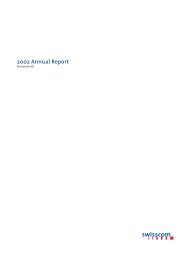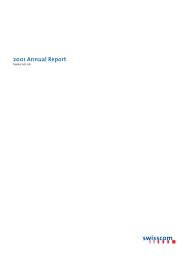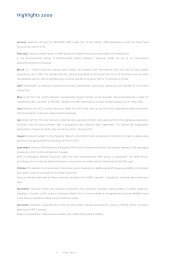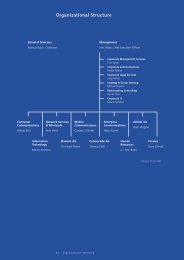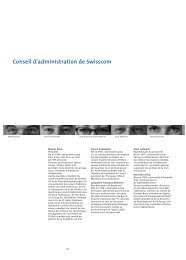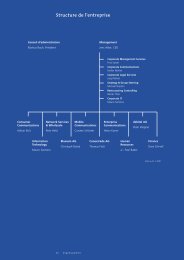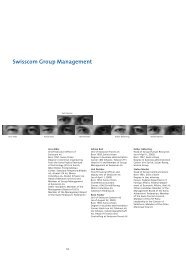Notes to the consolidated financial statements - Swisscom
Notes to the consolidated financial statements - Swisscom
Notes to the consolidated financial statements - Swisscom
Create successful ePaper yourself
Turn your PDF publications into a flip-book with our unique Google optimized e-Paper software.
3 Financial risk<br />
management<br />
rendered. The effects of changes in actuarial assumptions are systematically charged or<br />
credited <strong>to</strong> income over a period approximating <strong>the</strong> average expected remaining working<br />
lives of participating employees. The portion of actuarial gains and losses recognized is<br />
defined as <strong>the</strong> excess of <strong>the</strong> net cumulative unrecognized actuarial gains and losses at <strong>the</strong><br />
end of <strong>the</strong> previous reporting period over <strong>the</strong> greater of 10% of <strong>the</strong> present value of <strong>the</strong><br />
defined benefit obligation at that date (before deducting plan assets) or 10% of <strong>the</strong> fair<br />
value of any plan assets at that date. Past service cost attributable <strong>to</strong> plan amendments is<br />
recognized as an expense on a straight-line basis over <strong>the</strong> average period until <strong>the</strong> benefits<br />
become vested. To <strong>the</strong> extent <strong>the</strong> benefits immediately vest, <strong>the</strong> costs associated with<br />
<strong>the</strong> amendment is immediately recognized.<br />
For subsidiaries outside Switzerland, <strong>Swisscom</strong> contributes <strong>to</strong> a number of separate<br />
pension plans.<br />
Cus<strong>to</strong>mer acquisition costs<br />
<strong>Swisscom</strong> pays commissions <strong>to</strong> dealers for <strong>the</strong> acquisition and retention of mobile subscribers.<br />
The amount of commission that is payable is dependent on <strong>the</strong> type of new<br />
subscription package. In addition, <strong>Swisscom</strong> offers subsidies <strong>to</strong> new subscribers on <strong>the</strong> sale<br />
of mobile handsets. Cus<strong>to</strong>mer acquisition costs are recorded immediately in <strong>the</strong> income<br />
statement.<br />
Income taxes<br />
Deferred income taxes are determined using <strong>the</strong> comprehensive liability method whereby<br />
deferred income tax is recognized on all temporary differences. Temporary differences<br />
between <strong>the</strong> carrying value of an asset or liability used for tax purposes and that used for<br />
<strong>financial</strong> reporting purposes arise in one period and reverse in one or more subsequent<br />
periods. Deferred tax assets and liabilities are determined using <strong>the</strong> tax rates that are expected<br />
<strong>to</strong> apply when <strong>the</strong> asset is realized or <strong>the</strong> liability is settled. The deferred tax assets<br />
or liabilities are disclosed as long-term assets or liabilities with those changes being<br />
recorded in <strong>the</strong> statement of operations. Deferred tax assets are recognized if it is probable<br />
that benefits will be realized in <strong>the</strong> future.<br />
Related parties<br />
Under IAS, transactions with <strong>the</strong> Confederation, including its departments and agencies,<br />
are excluded from <strong>the</strong> scope of related party disclosures.<br />
Earnings per share<br />
Basic earnings per share is computed by dividing net income by <strong>the</strong> weighted-average<br />
number of shares outstanding for <strong>the</strong> year. The weighted-average number of shares outstanding<br />
excludes any treasury shares. Diluted earnings per share is similar <strong>to</strong> basic earnings<br />
per share, except that <strong>the</strong> weighted-average number of shares outstanding is increased<br />
<strong>to</strong> include <strong>the</strong> number of additional shares that would have been outstanding<br />
if dilutive potential shares had been issued.<br />
Comparatives<br />
Where necessary, comparative figures have been adjusted <strong>to</strong> conform with changes in<br />
presentation in <strong>the</strong> current year. Effective January 1, 2001, <strong>Swisscom</strong> adopted IAS 39 –<br />
Financial Instruments: Recognition and Measurement. In accordance with <strong>the</strong> transition<br />
requirements of IAS 39 <strong>the</strong> comparative <strong>financial</strong> <strong>statements</strong> for <strong>the</strong> year ended December<br />
31, 2000 have not been restated.<br />
<strong>Swisscom</strong>’s activities expose it <strong>to</strong> a variety of <strong>financial</strong> risks, including <strong>the</strong> effects of foreign<br />
currency exchange rates and interest rates. <strong>Swisscom</strong>’s overall risk management<br />
programme seeks <strong>to</strong> minimise potential adverse effects on <strong>the</strong> <strong>financial</strong> performance<br />
of <strong>Swisscom</strong>. <strong>Swisscom</strong> uses derivative <strong>financial</strong> instruments such as foreign exchange<br />
contracts and interest rate swaps <strong>to</strong> hedge certain exposures resulting from <strong>the</strong> Group’s<br />
commercial activities.<br />
Financial risk management is carried out by a central treasury department (Group Treasury)<br />
under policies approved by <strong>the</strong> Board of Direc<strong>to</strong>rs. Group Treasury identifies, evaluates<br />
and hedges <strong>financial</strong> risks in close co-operation with <strong>the</strong> operating units. Group Treasury<br />
has guidelines approved by <strong>the</strong> Board for overall risk management, as well as written<br />
policies covering specific areas, such as foreign exchange risk management, cash mana-<br />
25 <strong>Swisscom</strong> Consolidated <strong>financial</strong> <strong>statements</strong>






